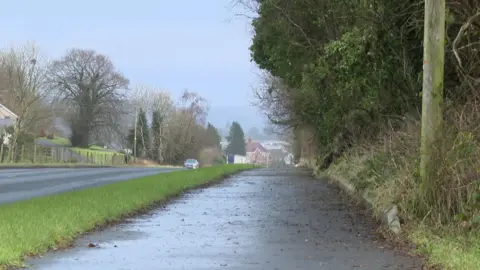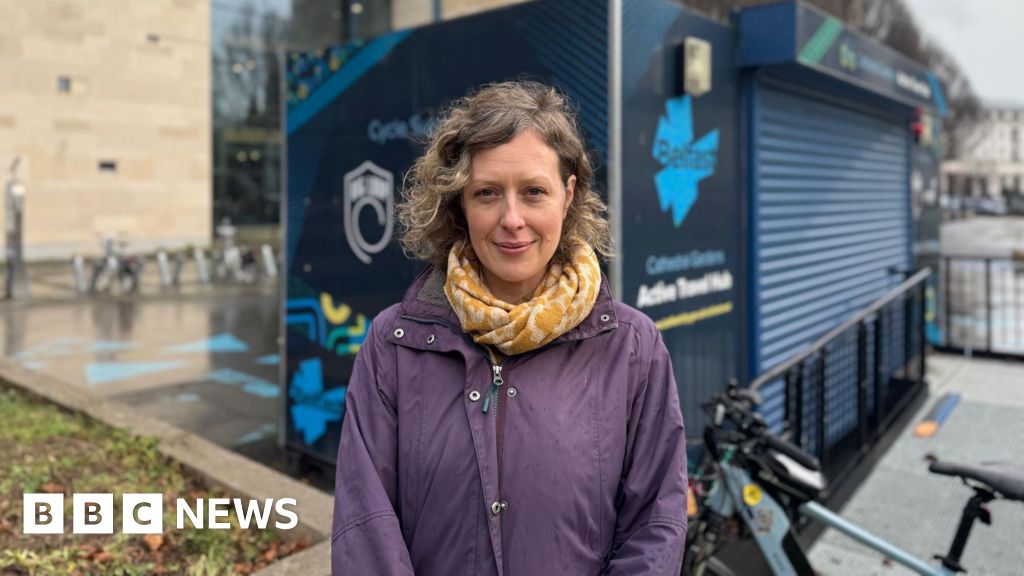 BBC
BBCThe Department for Infrastructure is not on track to meet legally binding active travel spending targets, according to a number of campaign groups.
Under the Climate Act 2022, the department has a legal obligation to reach a target spend of at least 10% of its overall annual budget on active travel projects by 2030.
That equates to more than £80m a year but it is currently spending about £12m a year.
The department said it is “committed to ramping up investment to meet the department’s Climate Change Act obligations by 2030”.
Northern Ireland has the lowest per capita spend on active travel compared to the rest of the UK and the Republic of Ireland.
Developing active travel means building physical infrastructure which has a tangible impact on encouraging people to walk or cycle instead of driving in an effort to reduce carbon emissions.
Meghan Hoyt from the Belfast Cycle Campaign said active travel delivery was “woeful” which made it “hard to stay optimistic and positive”.
She added that groups “might have to look at” coming together to use legal pressure to see change.
Declan Allison from Friends of the Earth said legal action can have “a very powerful impact”.
“Deadlines have already been missed, they have to get on with it,” he added.
Belfast is ’20 years behind’

According to a report by the active travel charity Sustrans, the whole of Belfast city has only two miles of protected bike lanes.
Protected bike lanes separate cyclists from other traffic by using physical barriers like curbs or bollards.
On Monday, the DfI announced a £580,000 scheme to improve pedestrian and cycling access to Stranmillis Embankment in Belfast.
Sustrans questioned why DfI decided to spend this improving existing infrastructure rather than developing new bike lanes elsewhere.
Stephen McNally from the campaign group Cycul said Belfast is 15 or 20 years behind Dublin in terms of active travel, and further behind other European cities.
He pointed to the planned Belfast Bicycle Network 2017, the delivery plan for which was not launched until 2022.
He said “there hasn’t been one metre delivered” since.
The department maintains that a “number of schemes on the Belfast Cycling Network have been completed since its publication in March 2022, with more schemes progressing this financial year”.
This includes “progressing the £23-28m Lagan Pedestrian and Cycle Bridge project”.
In November, Infrastructure Minister John O’Dowd launched a consultation on the active travel delivery plan and committed to spend £200m over the next decade on active transport schemes in towns across Northern Ireland.
It was the ninth DfI consultation or strategy within the last 10 years on active travel.
Mr McNally said a lot had been promised over the years but there has been “next to no delivery on the ground”.
He describes it as “another case of kicking another very difficult decision up the road for another three or four years”.
Cycle lanes to nowhere
Mr McNally has also questioned if the money being used is being spent effectively.
He claimed some active travel projects outside of Belfast “lead to nowhere, and don’t connect anything to anywhere”.
About £170,000 of active travel budget was spent installing a wide footway along a stretch of the busy Clabby Road in Fivemiletown.
The project begins on a B-road and connects to no schools, shops or other amenities.

Mr McNally said some projects “seem to be a round-about way to do a road resurfacing project and claim it as active travel because there’s a bike lane stuck on”.
Earlier this year, £2.6m of the active travel budget was allocated to road works on a stretch of the A2 Clooney Road in Greysteel, County Londonderry.
A large portion of the cost of the project is for road resurfacing for cars and lorries, and a cycle lane is being added.

A DfI spokesperson said: “In order to provide the necessary space to create the active travel infrastructure, it is necessary to move kerb lines, reposition drainage and remove the hard shoulder.
“Without the realignment of the road, an active travel scheme could not be delivered.
“Therefore, this is active travel expenditure.”
‘Politically easy’
Campaigners have been increasing the pressure on the DfI since congestion in Belfast was putting “severe pressure” on commuters and their employers during recent months.

Andrew McClean from Cycling UK said people are “not likely” to make active travel journeys “along ring roads or rural roads”.
He suggests the department is doing what is “politically easy”.
“No one is going to object to widening the footpath on a ring road where you are not competing with other interests,” he said.
Putting active travel infrastructure in places where it is likely to be used requires making “bold political decisions”, he added.


